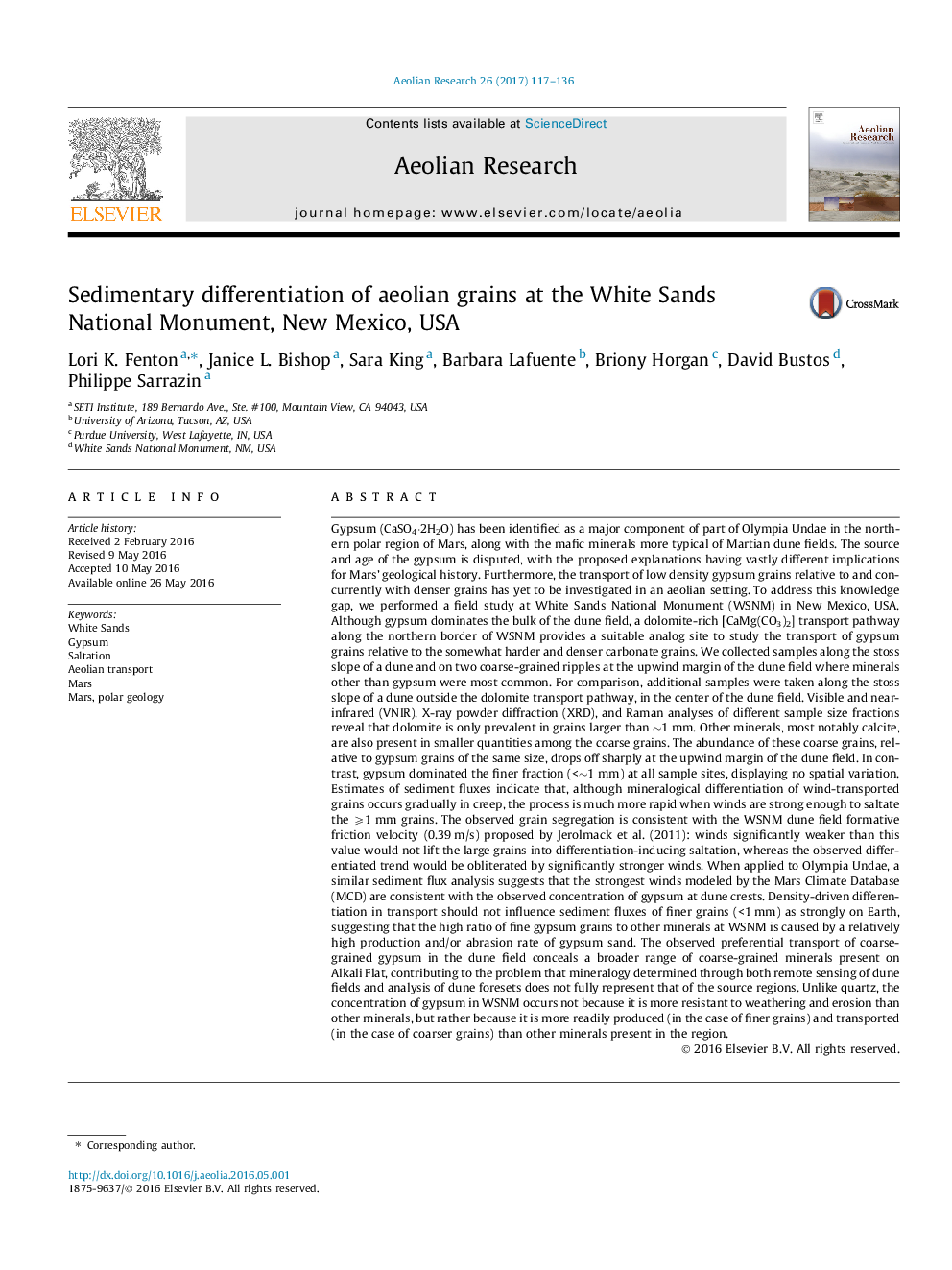| کد مقاله | کد نشریه | سال انتشار | مقاله انگلیسی | نسخه تمام متن |
|---|---|---|---|---|
| 5779101 | 1634102 | 2017 | 20 صفحه PDF | دانلود رایگان |
- Sand grains >1Â mm at White Sands National Monument show sedimentary differentiation.
- Saltation, rather than creep, of >1Â mm grains is responsible for mineral segregation.
- The differentiation may conceal the mineralogical diversity of source regions.
- Spatial segregation of barely saltatable grains can help constrain formative winds.
- Sand grains <1Â mm are differentiated by grain production or abrasion, not saltation.
Gypsum (CaSO4·2H2O) has been identified as a major component of part of Olympia Undae in the northern polar region of Mars, along with the mafic minerals more typical of Martian dune fields. The source and age of the gypsum is disputed, with the proposed explanations having vastly different implications for Mars' geological history. Furthermore, the transport of low density gypsum grains relative to and concurrently with denser grains has yet to be investigated in an aeolian setting. To address this knowledge gap, we performed a field study at White Sands National Monument (WSNM) in New Mexico, USA. Although gypsum dominates the bulk of the dune field, a dolomite-rich [CaMg(CO3)2] transport pathway along the northern border of WSNM provides a suitable analog site to study the transport of gypsum grains relative to the somewhat harder and denser carbonate grains. We collected samples along the stoss slope of a dune and on two coarse-grained ripples at the upwind margin of the dune field where minerals other than gypsum were most common. For comparison, additional samples were taken along the stoss slope of a dune outside the dolomite transport pathway, in the center of the dune field. Visible and near-infrared (VNIR), X-ray powder diffraction (XRD), and Raman analyses of different sample size fractions reveal that dolomite is only prevalent in grains larger than â¼1 mm. Other minerals, most notably calcite, are also present in smaller quantities among the coarse grains. The abundance of these coarse grains, relative to gypsum grains of the same size, drops off sharply at the upwind margin of the dune field. In contrast, gypsum dominated the finer fraction (<â¼1 mm) at all sample sites, displaying no spatial variation. Estimates of sediment fluxes indicate that, although mineralogical differentiation of wind-transported grains occurs gradually in creep, the process is much more rapid when winds are strong enough to saltate the ⩾1 mm grains. The observed grain segregation is consistent with the WSNM dune field formative friction velocity (0.39 m/s) proposed by Jerolmack et al. (2011): winds significantly weaker than this value would not lift the large grains into differentiation-inducing saltation, whereas the observed differentiated trend would be obliterated by significantly stronger winds. When applied to Olympia Undae, a similar sediment flux analysis suggests that the strongest winds modeled by the Mars Climate Database (MCD) are consistent with the observed concentration of gypsum at dune crests. Density-driven differentiation in transport should not influence sediment fluxes of finer grains (<1 mm) as strongly on Earth, suggesting that the high ratio of fine gypsum grains to other minerals at WSNM is caused by a relatively high production and/or abrasion rate of gypsum sand. The observed preferential transport of coarse-grained gypsum in the dune field conceals a broader range of coarse-grained minerals present on Alkali Flat, contributing to the problem that mineralogy determined through both remote sensing of dune fields and analysis of dune foresets does not fully represent that of the source regions. Unlike quartz, the concentration of gypsum in WSNM occurs not because it is more resistant to weathering and erosion than other minerals, but rather because it is more readily produced (in the case of finer grains) and transported (in the case of coarser grains) than other minerals present in the region.
Journal: Aeolian Research - Volume 26, June 2017, Pages 117-136
